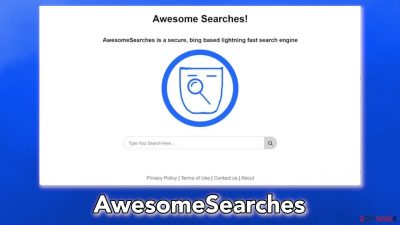AwesomeSearches browser hijacker (virus) - Free Guide
AwesomeSearches browser hijacker Removal Guide
What is AwesomeSearches browser hijacker?
AwesomeSearches is a useless extension that pretends to provide a better browsing experience

AwesomeSearches is a browser plugin that changes the main settings of the browser, like the homepage, new tab address, and search engine. For these reasons, it is classified as a browser hijacker. It may also cause an increased amount of commercial content, like pop-ups, banners, and redirects.
Users are forced to use only selected channels for browsing which raises user privacy and security concerns. The default search engine is set to Bing disguised as AwesomeSearches Search, and the search queries start being redirected through awesomesearches.com.
Crooks present the plugin as a “secure, bing based lightning fast search engine.” The extension does not provide any benefits whatsoever. If you want to use Bing, it is best to use it directly that add a third-party app to your browser. It may track your browsing activity and redirect you to dangerous pages.
As a result, people may be tricked into giving away their personal information, downloading PUPs (potentially unwanted programs),[1] and even malware.
| NAME | AwesomeSearches |
| TYPE | Browser hijacker; potentially unwanted program |
| SYMPTOMS | The main settings of the browser get changed, like the homepage, new tab address, and search engine; users may also start seeing more ads and more promotional links injected into the search results |
| DISTRIBUTION | Shady websites; deceptive ads; freeware installations |
| DANGERS | The plugin forces people to use only selected channels for browsing which raises many user privacy and security concerns |
| ELIMINATION | Remove the add-on through the browser settings |
| FURTHER STEPS | Use a repair tool like FortectIntego to clear your browsers and fix any remaining damage |
Distribution methods
Usually, users infect themselves with bogus browser extensions from fake “Downloader” pages that use social engineering methods.[2] You may encounter messages like “Install Recommended Chrome Extension.” Often, such pages do not display the names of the plugins, so that should be a red flag.
Although it is rare, some browser hijackers slip through the extensive review process that official web stores perform. That is why it is important to do your research no matter where you are installing the applications from. Read the reviews, look at the ratings, and the number of users.
It is best to choose those plugins that have plenty of positive feedback and thousands of users. You should also read the descriptions fully as crooks often make grammar or spelling mistakes. Also, if the claims are too good to be true – they probably are.

Software bundling
Another possibility is that you installed the AwesomeSearches browser hijacker unknowingly. This can happen if you use freeware[3] distribution platforms. They often include additional programs in the installers and do not disclose it clearly on their pages.
You need to be attentive during the installation process. Always choose the “Custom” or “Advanced” installation methods. Read the Privacy Policy and Terms of Use to find out what the program will be capable of in your machine. The most important part is to check the file list and untick the boxes next to any unrelated applications.
The reason why you should be careful of bundled software[4] is that most often it includes programs that monetize the user activity. They can also be disguised as “handy” tools to make it more difficult for users to identify them. It is best not to use third-party sources for software installations altogether.
Remove the extension
The first thing you should do is go to your browser settings and check if you see AwesomeSearches in the list, any extensions with a similar name, or suspicious-looking add-ons in general. You can follow our guide if you need help:
Google Chrome
- Open Google Chrome, click on the Menu (three vertical dots at the top-right corner) and select More tools > Extensions.
- In the newly opened window, you will see all the installed extensions. Uninstall all the suspicious plugins that might be related to the unwanted program by clicking Remove.
![Remove extensions from Chrome Remove extensions from Chrome]()
MS Edge:
- Select Menu (three horizontal dots at the top-right of the browser window) and pick Extensions.
- From the list, pick the extension and click on the Gear icon.
- Click on Uninstall at the bottom.
![Remove extensions from Edge Remove extensions from Edge]()
MS Edge (Chromium)
- Open Edge and click select Settings > Extensions.
- Delete unwanted extensions by clicking Remove.
![Remove extensions from Chromium Edge Remove extensions from Chromium Edge]()
Mozilla Firefox
- Open Mozilla Firefox browser and click on the Menu (three horizontal lines at the top-right of the window).
- Select Add-ons.
- In here, select unwanted plugin and click Remove.
![Remove extensions from Firefox Remove extensions from Firefox]()
Safari
- Click Safari > Preferences…
- In the new window, pick Extensions.
- Select the unwanted extension and select Uninstall.
![Remove extensions from Safari Remove extensions from Safari]()
Protect your privacy
Almost all websites and browser plugins use cookies[5] to track your activity. Normally, they are used to personalize the user experience but crooks can use them to make a profit and sell them to advertising networks or other third parties. These small text files can store information such as your IP address, geolocation, links you click on, things you purchase online, etc.
We recommend using a maintenance tool like FortectIntego to clear your browsers automatically. Besides, this powerful software can fix various system errors, BSODs, corrupted files, and registry issues, which is especially helpful after a virus infection.
Check your system for PUP infections
If you performed all the previous removal steps but you still experience the unwanted symptoms, you should consider the possibility that your machine is infected by a potentially unwanted program. It can have any name or icon so it can be difficult to remove it manually for the average user.
If you are not sure what to do and you do not want to risk eliminating the wrong files, we suggest using SpyHunter 5Combo Cleaner or Malwarebytes security tools that will scan your machine, eliminate it, and prevent such infections in the future by giving you a warning before a malicious program can make any changes. If manual removal is what you prefer, we have instructions for Windows and Mac machines:
Windows 10/8:
- Enter Control Panel into Windows search box and hit Enter or click on the search result.
- Under Programs, select Uninstall a program.
![Uninstall from Windows 1 Uninstall from Windows 1]()
- From the list, find the entry of the suspicious program.
- Right-click on the application and select Uninstall.
- If User Account Control shows up, click Yes.
- Wait till uninstallation process is complete and click OK.
![Uninstall from Windows 2 Uninstall from Windows 2]()
Windows 7/XP:
- Click on Windows Start > Control Panel located on the right pane (if you are Windows XP user, click on Add/Remove Programs).
- In Control Panel, select Programs > Uninstall a program.
![Uninstall from Windows 7/XP Uninstall from Windows 7/XP]()
- Pick the unwanted application by clicking on it once.
- At the top, click Uninstall/Change.
- In the confirmation prompt, pick Yes.
- Click OK once the removal process is finished.
Mac:
- From the menu bar, select Go > Applications.
- In the Applications folder, look for all related entries.
- Click on the app and drag it to Trash (or right-click and pick Move to Trash)
![Uninstall from Mac 1 Uninstall from Mac 1]()
To fully remove an unwanted app, you need to access Application Support, LaunchAgents, and LaunchDaemons folders and delete relevant files:
- Select Go > Go to Folder.
- Enter /Library/Application Support and click Go or press Enter.
- In the Application Support folder, look for any dubious entries and then delete them.
- Now enter /Library/LaunchAgents and /Library/LaunchDaemons folders the same way and terminate all the related .plist files.
![Uninstall from Mac 2 Uninstall from Mac 2]()
How to prevent from getting browser hijacker
Access your website securely from any location
When you work on the domain, site, blog, or different project that requires constant management, content creation, or coding, you may need to connect to the server and content management service more often. The best solution for creating a tighter network could be a dedicated/fixed IP address.
If you make your IP address static and set to your device, you can connect to the CMS from any location and do not create any additional issues for the server or network manager that needs to monitor connections and activities. VPN software providers like Private Internet Access can help you with such settings and offer the option to control the online reputation and manage projects easily from any part of the world.
Recover files after data-affecting malware attacks
While much of the data can be accidentally deleted due to various reasons, malware is one of the main culprits that can cause loss of pictures, documents, videos, and other important files. More serious malware infections lead to significant data loss when your documents, system files, and images get encrypted. In particular, ransomware is is a type of malware that focuses on such functions, so your files become useless without an ability to access them.
Even though there is little to no possibility to recover after file-locking threats, some applications have features for data recovery in the system. In some cases, Data Recovery Pro can also help to recover at least some portion of your data after data-locking virus infection or general cyber infection.
- ^ Potentially unwanted program. Wikipedia, the free encyclopedia.
- ^ What is Social Engineering?. Webroot. Cybersecurity Resources.
- ^ Tim Fisher. What Is Freeware?. Lifewire. Internet, Networking, and Security.
- ^ Liam Tung. Google: Unwanted bundled software is way more aggressive than malware. Zdnet. Security Blog.
- ^ Chris Maus. What Are Cookies and Are They Dangerous?. Qkey. Secure Online Payment Providers.










